Jiande, a thousand-year-old ancient city on the banks of the Xin'an River, is a place where you can explore the aviation town and realize your dream of flying in the sky.
Preface
When you think of Hangzhou, what comes to mind? West Lake, Leifeng Pagoda, Lingyin Temple, Liangzhu culture, the G20 Summit, the Asian Games, and so on. Surrounding Hangzhou are beautiful places like Lin'an, the capital of the prefecture, Tonglu, depicted in the painting "Dwelling in the Fuchun Mountains," and Chun'an, home to Thousand Island Lake. But there's also a place not only beautiful but also historically significant: Jiande City.
Jiande History

Jiandecheck the details
Jiande City, located in the upper reaches of the Qiantang River, boasts beautiful mountains and rivers, straddling the "Two Rivers and One Lake" (Fuchun River, Xin'an River, and Qiandao Lake). Rich in tourism resources, Jiande is one of the first nationally designated key scenic spots. Its tourism routes are centered on the Xin'an River, with three main routes: East, South, and West. The East route features the "Qili Yangfan" scenic area in the Qililong area of the Fuchun River, a breathtaking landscape gallery. The South route features Lingqi Dongtian (Lingxi Cave) and Daciyan (Daici Rock), known as Jiangnan's premier hanging temple. The West route offers scenic spots such as the Xin'an River Hydropower Station and Qiandao Lake. Other attractions include the Turtle Cave, Lover's Valley, the Ten-Mile Lotus Scenic Area, and the New Leaf Ancient Ming House.
Recommended month: All seasons
6444 comments, 4650 visits
Jiande, a county-level city, is administered by Hangzhou and is the only county-level city under the jurisdiction of Hangzhou. This shows its importance.
Jiande is located at the junction of Hangzhou, Jinhua and Quzhou. Its rich cultural history and superior geographical environment have created Jiande's unique charm. The Xin'an River, Lan River and Fuchun River converge here, forming an ancient historical city called Yanzhou (which no longer exists). Although the ancient city has been divided into various places, the marks left by history are still worth recalling.

Jiande is now a vibrant, ecologically green and civilized city, boasting abundant tourist attractions such as Thousand Island Lake, the Hanging Temple in Jiangnan, and the ancient Xinye dwellings. It's a perfect choice for a self-driving tour from Hangzhou. In recent years, Jiande has also seen the emergence of a fascinating attraction: Aviation Town, a national-level aviation-themed town, aiming to become an internationally renowned general aviation leisure tourism destination, perfect for family trips and educational activities. Jiande is a great choice for exploring Hangzhou. Here's how to spend three days and two nights there.
Meicheng, a thousand-year-old ancient town

Meicheng Ancient Towncheck the details
Meicheng Ancient Town, located at the confluence of the Xin'an and Lanjiang Rivers, was the seat of the ancient Muzhou Prefecture, Yanzhou Prefecture, and Jiande County. Built along the river, Meicheng Ancient Town boasts a history of over 1,700 years, named for its ancient city walls shaped like plum blossoms. Two lakes flank the city walls to the east and west, while twin towers stand facing each other from north to south. Within the city, scenic spots such as the Sifan Memorial Archway, the Jiande Marquis Archway, the Minggui Green Branches, and the Liuhe Ancient Well offer opportunities for historical exploration. Surrounding the city, scenic spots such as Yuquan Temple, Fengzhen Taoist Temple, Wulong Ridge, Wansong Forest, the Twin Towers Soaring to the Clouds, and the "Two Rivers Forming a Character" offer fascinating exploration. Legend has it that when Tang Bohu was traveling along the river, he suddenly saw the northern and southern peaks facing each other across the river, each crowned by an ancient tower soaring into the clouds. He exclaimed, "What a magnificent sight! Twin towers soaring to the clouds!" The story of Song Jiang's expedition against Fang La in the last forty chapters of "Water Margin", one of the four great classical novels, took place here. Meicheng also has a profound cultural connection with historical masterpieces such as "Strange Stories from a Chinese Studio".
Recommended month: All seasons
433 reviews, 393 visits
Our first stop in Jiande was Meicheng, a thousand-year-old town on the banks of the Xin'an River. Many people may not be familiar with Meicheng, but it is the most historical place in Jiande and was once the seat of the ancient Yanzhou Prefecture.

"There are two and a half plum blossoms in the world: one in Beijing, one in Nanjing, and half in Yanzhou." This is the beautiful reputation of Meicheng, which got its name from the battlements along the river of the ancient Yanzhou city wall, which were built in the shape of a plum blossom. Historically, in the fourth year of Huangwu (225) during the Three Kingdoms period of the Wu Dynasty, Jiande County was established, with Meicheng as the county seat. In the first year of Shengong (697) during the Tang Dynasty, the Muzhou prefecture seat was moved from Zhishan (now Chun'an) to Meicheng. From then until 1959, Meicheng served as the seat of prefectures, prefectures, roads, and special administrative offices, boasting a history of over 1,700 years.

The tour of Meicheng starts from the city wall. At present, the city wall along the river has been preserved and repaired. You can climb up the city wall for sightseeing. Sections of the city wall and city gates, traveling through history and gazing into the distance, now stand safely on the bank of the Xin'an River.

Meicheng Ancient Town is located in a place with beautiful mountains, clear waters, outstanding people and favorable enviroment. It is backed by Wulong Mountain and faces Sanjiangkou. Xin'an River, Lan River and Fuchun River converge here. It is nestled between mountains and waters, with beautiful scenery and comfortable environment. The ancient town is safe and the sun shines warmly in the winter afternoon.

Entering Meicheng Ancient Town, you'll experience this ancient city up close. The main street is quite spacious, likely retaining its original appearance with minimal changes, demonstrating just how prosperous Meicheng once was. A stone archway several dozen meters high stands majestically in the middle. Shops flank the streets, while two-, three-, four-, and five-story buildings are tightly connected. While uneven, the layout is remarkably harmonious, avoiding any clutter.

With its blue bricks, black tiles and horse-head walls, Meicheng's architecture embodies the essence of Huizhou architecture. In fact, it is not difficult to imagine that the former Yanzhou Prefecture was adjacent to Huizhou Prefecture, and the "Hui" in Anhui Province comes from this. Huizhou is the center of Huizhou culture and the birthplace of Huizhou architecture. So, as the seat of Yanzhou Prefecture, it is not surprising that the buildings in Meicheng inherit the characteristics of Huizhou architecture.

Today, the urban area of Jiande is dozens of kilometers away from the ancient town of Meicheng, which may be one of the important reasons why people have forgotten Meicheng.
In fact, Meicheng has appeared many times in famous Chinese classical novels, including "Water Margin", "The Scholars", "Officialdom Unmasked", "Jin Ping Mei", etc., all of which have described the humanities and landscapes of Meicheng.

The memorial archways in the ancient town will surely impress you. They are lined up along the main street, with no end in sight, which is very spectacular. In fact, there are many memorial archways not only on the main street, but also on the branch roads extending next to it. I haven’t counted how many there are. Looking at these vicissitudes of life, they are witnesses of historical changes and have extremely high historical research value. They are worthy of our careful appreciation and understanding one by one. The story of Meicheng may be hidden in them.


Literary men and women such as Meng Haoran, Xie Lingyun, and Li Bai have all traveled to the mountains and rivers of Meicheng. Literary men such as Du Mu, Fan Zhongyan, Lu You, and Liu Changqing have also served as officials here. If you go deep into the town of Meicheng, you will find that it is an ancient town with a rich heritage.

The ancient town is a great place to stroll, relax, and calm your mind. Walking slowly on the bluestone slabs, you can see the city gate in the distance and the distant mountains. Being in Meicheng, you can feel the passage of time. The ancient town is open to the public free of charge, and there aren't many tourists yet. If you're interested, be sure to come early.

If you are hungry, you may want to try some of Meicheng's special snacks, such as Yanzhou sesame cakes, Yanzhou dried vegetable duck, Meicheng handmade noodles, stinky tofu corn cakes, etc., which are all delicacies with unique local flavor.

The ancient town is not very big. The parts that can be visited at present are the city wall and a main street. The whole journey takes about two hours.
Xin'an Riverside Banmeiju
The place we stayed today was Banmeiju, a boutique B&B not far from Meicheng Ancient Town. The name of the B&B is concise and very fitting for Meicheng. You can really see the city wall from the balcony in the room. It takes about fifteen minutes to walk back slowly from the ancient town.

The B&B is located in the upper part of a high-end villa complex, perched atop a hill, offering expansive views overlooking the Xin'an River and Meicheng Ancient Town. The B&B itself is part of the villa complex, offering a tranquil and tranquil environment. The modern, standard architecture, combined with the traditional building signs and framed doors, creates a sense of privacy.

The single-family villas are named as Mountain Residence, Water Residence and Cloud Residence to distinguish their different characteristics. Each villa contains four rooms of different types, and the landscape is also different. The bottom floor is designed as a living room, which includes a separate private courtyard. The rooms can be booked individually, and the villa can be booked as a whole. It is a suitable choice for vacations with families and friends, and is also suitable for group travel, banquets, parties and other activities.

The villa is cleverly designed, nestled against the mountainside, with two upper floors and three lower floors. The balconies face opposite directions, allowing each to enjoy its own unique view without interfering with the other. The homestay also boasts a spacious common area, including a swimming pool, tea room, and restaurant, to meet your holiday needs.

The room is medium in size but very cozy, with an overall casual vacation style, wooden floors and solid wood furniture, combining traditional Chinese style with European home decoration design, low-key yet restrained, extra-large panoramic floor-to-ceiling glass sliding doors, and an extra-large balcony outside where you can overlook the distant landscape.

Although the room is not large, it has different functional areas. The mini bar provides tea and water, and the washing area is also equipped with a cloakroom to meet your vacation needs.

The simple design separates the living room and bedroom areas. The mattress is relatively hard, the bedding is soft and comfortable, and it is matched with high and low pillows.

The bedside is designed with a USB port, which is extremely convenient for traveling. The metal chandelier has a unique design, which greatly improves the overall texture.

The living room area looks very harmonious, with a sofa, coffee table, small round table, and an extra-large LCD TV to meet your vacation needs. It can also be used as an office, allowing you to balance work and leisure.

The washroom is separated into wet and dry areas, the separate washbasin is clean and tidy, the gray, black and white tones are very high-end, and the toiletries are customized by themselves, and the quality is quite high after personal testing.

The overall experience of staying at the B&B is very good and comfortable. In the evening, when the sun sets, the sunset view of Xin'an River is in the distance. It is so beautiful.
Jiande Flavor
Today's dinner was enjoyed in the B&B. Due to its geographical location, although Jiande is part of Hangzhou, it does not have the flavor of Hangzhou cuisine. Instead, the spicy taste is prominent, which is impressive.

The secret pig skin jelly is full of collagen and soybeans are added to it, which not only enriches the taste but also increases the nutritional value.

Compared with Jiangnan cuisine and Northwest cuisine, this white-cut lamb dish fully demonstrates the tenderness and delicacy of Jiangnan. The lamb is handled very cleanly, and the skin part is selected, with fat and lean parts. The crystal clear leather is chewy, the lamb is delicate, and the mutton is full of mutton flavor.

Farmhouse tofu looks very good. Purely handmade tofu is rare in the city. Such handmade tofu is particularly precious. It is superior in both texture and taste. It tastes great when eaten with sauce and has a strong bean flavor.

Stewed bamboo shoots with bacon is a common dish in the Jiangnan region and is also a very representative dish. The combination of the flavor of bacon and the sweetness of bamboo shoots is very memorable.

Spicy pig tail, the pig tail part is mostly leather, and it is also full of collagen. The soup is very thick and looks very tempting. The leather is soft and glutinous, full of flavor, and the lean meat in the middle is also very delicate.

Pork belly stewed with shank bones is made from the same ingredients, and the flavors blend together. The pork belly is delicate and soft, with an excellent taste. The meat on the shank bones is also crispy and tender, and is infused with the special aroma of the pork belly. It is common in Jiande to use chili as a side dish, just like we would add coriander and chopped green onions.

Palace Han Steamed Chicken is one of their most popular specialties. The pig's feet and the whole chicken are put into a casserole together and stewed until the soup is thick and then the heat is turned off. The caramel color along the wall of the casserole is a sign that the dish is done, and the aroma is overflowing. The chicken is so soft that it can be easily separated with chopsticks. The chicken skin is fragrant and glutinous and the fat has long melted, making the taste more refreshing. The pig's feet are chewy and full of flavor, and they are full of soup, which is very memorable.

Although grilled fish is very common, it is not easy to make it delicious. Their chef is very good. This grilled fish is very well made, crispy on the outside and tender on the inside. Most importantly, it is very flavorful and the spiciness is quite satisfying.

Fermented duck looks like pickled duck at first glance, but its appearance is stickier than pickled duck, as if it is coated with a layer of syrup. The taste is somewhat similar to pickled duck, but it has the sweet aftertaste of fermented rice.

Chestnut and Pumpkin Casserole. There are actually no chestnuts in this dish. It’s the pumpkin that has a powdery texture, just like eating chestnuts. It is slowly heated in a ceramic pot to keep the residual heat. Later, part of the bottom of the pumpkin has become burnt, and it tastes better at this time.

This dish is very characteristic of Jiande. It is said to be a must-have dish in major local banquets. It is a little different from the meatballs we usually eat. Minced meat and shredded radish are added to sweet potato flour and mixed into a ball, then steamed until cooked. It has a soft and slightly chewy texture, and the mouth is full of meaty aroma and the sweetness of radish.

Handmade glutinous rice balls are also a specialty of Jiande. It is surprising to see that they are so big and called glutinous rice balls. Moreover, these glutinous rice balls are not sweet but salty, with fillings of minced meat and some vegetables, and the taste is quite good.
Aviation Town
The Aviation Town is located in the provincial economic development zone in the southwest of Jiande. It is a characteristic town integrating aircraft assembly and manufacturing, maintenance, training, aviation tourism and aviation sports events.
The town aims to develop into an aviation theme park, creating an internationally renowned general aviation leisure tourism destination. It has a strong aviation atmosphere and a wealth of exciting study and travel courses, making it very suitable for family travel.

Located at the junction of Hangzhou, Jinhua, and Quzhou, it offers convenient transportation and is not far from the Qiandao Lake National 5A Scenic Area. Since its opening, the Aviation Town has become quite well-developed and highly accessible, making it a great choice for self-driving tours.
The town is divided into three major areas: aviation leisure and tourism area, aviation service area, and aviation manufacturing area. Tourists mainly visit the aviation leisure and tourism area, which is a leisure and entertainment complex with Henggang Industrial Site as its core, integrating aviation science and technology center, train square, airplane theme restaurant, and Xin'anjiangyu Hot Spring. It covers catering, accommodation, entertainment and other aspects to solve the travel problems of tourists.

The aviation service area is mainly a place for tourists to experience. It includes runways, hangars, and aprons. It provides airport fuel supply, aircraft maintenance, private and commercial license training, and aerial tours. There are also projects such as car parks and hot air balloon bases. The aviation manufacturing area has little to do with tourists and is a comprehensive service system within the jurisdiction.

The Aviation Town was built on the site of the former Hengshan Iron and Steel Plant. Unlike other cities, this is a cultural and creative park with aviation tourism as its theme. Not to mention it is the first of its kind in Zhejiang, it can be said to be unique even in the whole country.

The preserved red brick factory buildings within the park are particularly charming and a great place for photos. The Hengshan Iron and Steel Plant was established on the site of the Xin'anjiang Hydropower Station. The well-known Qiandao Lake is actually the Xin'anjiang Reservoir, which was created due to the completion of the Xin'anjiang Hydropower Station. To learn more about this history, visit the Hengshan Iron and Steel Memorial Hall.

Let me recommend to you some interesting places in Aviation Town.
Car Park
In the car-themed area, you can experience the speed and passion of driving. There is also a professional racing track that can be used for competitions. There are also theme restaurants and cafes in the park. The viewing angles are very good. Transformers and various graffiti make you feel like you are in an American rock park. Such an environment is very suitable for holding a concert and will surely set the whole audience on fire.


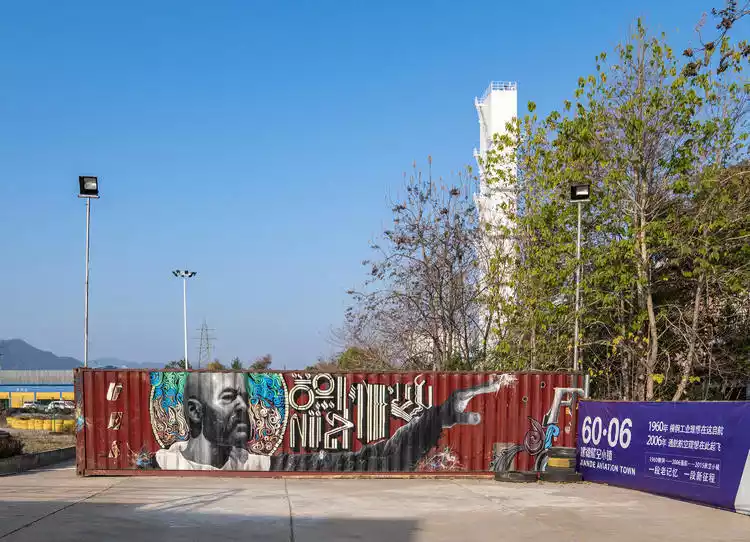
Train Square
Built on the original railway tracks of Henggang, the abandoned green trains were moved here and transformed into a very distinctive train restaurant and train hotel. Eating and sleeping here must be a unique experience.
The entire carriage is equipped with a complete locomotive and old railway tracks. It is also a great place to take photos and check in.




Airplane Theme Restaurant
Yes, this is a real big plane, a Boeing 737 passenger plane, with a very obvious China Eastern Airlines livery. The interior has been completely renovated, and the cockpit is retained for visitors to visit. There are almost no changes. Our great curiosity has finally allowed us to know what the cockpit of the plane looks like. We can also go in and observe it up close, which is also a good place to take photos and check in.
This is the eighth airplane-themed restaurant in the world and the second in China. It has a variety of experience projects including a Western restaurant, a theme music bar, a leisure tea bar, and an open-air barbecue.
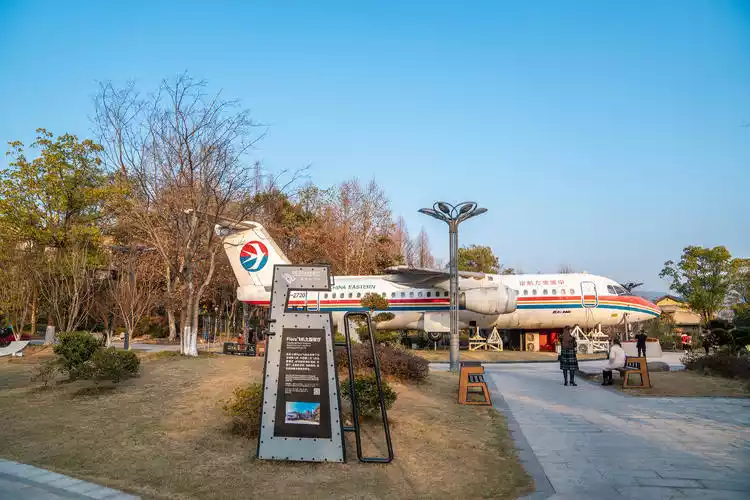
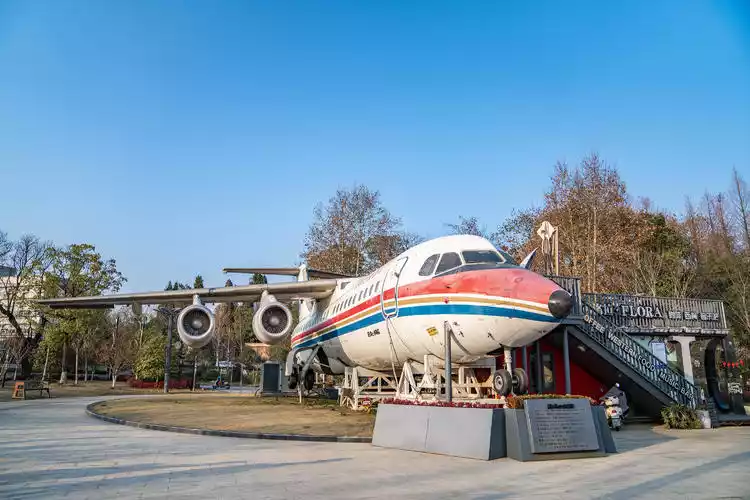
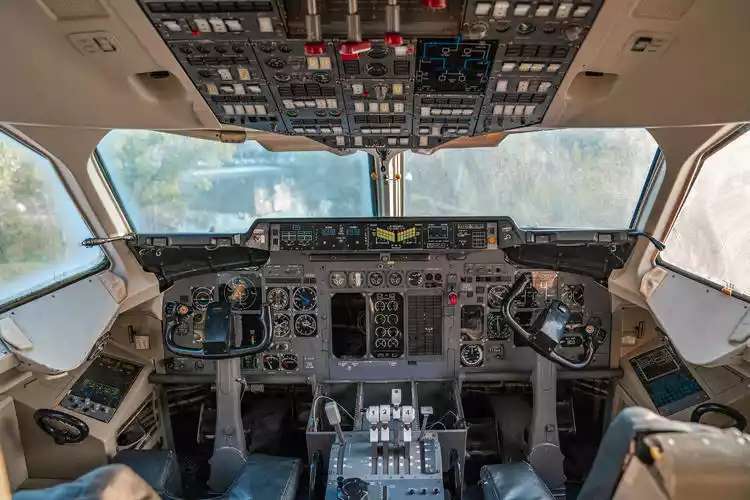
Aviation Town is a great place for taking photos, and I suggest you come and check it out.
Xinlian Aviation Science Center
Do you also have a dream of flying? Have you ever been passionate about aviation? I guess this is a wish that all children have had, imagining that they can fly in the blue sky like a bird. Including you and me, we must have thought so when we were children.

There is a place in the Aviation Town where you can learn about aviation knowledge in all aspects and in all directions. That is the Xinlian Aviation Science and Technology Center. The study and travel courses here are very attractive. The aviation science and technology study and travel camp has also been selected as the Hangzhou primary and secondary school students' study and travel camp. Only four camps in Hangzhou have received this honor.

The aviation science and technology research camp is divided into two major areas: indoor teaching venues and outdoor activity venues. The first part is the indoor part. The aviation science and technology center of more than 1,600 square meters is divided into multiple spaces. The children put on little pilot costumes and followed the professional staff of the venue for today's research and study tour. Parents can also watch and learn together.

The fighter jets at the entrance are real ones that have been on the battlefield. They are now retired and put on display in the venue. The real feeling is still quite shocking. The children must be full of curiosity about this. Interest is always the best teacher. This is how this meaningful study course slowly begins.

Study tour courses
Part 1: Circular Cinema in the Science Center
Beginning with the August 14th Jianqiao air battle in 1937 and extending to the scale of the Chinese Air Force after the founding of the People's Republic of China, the film recounts the history of modern Chinese air combat and the development of its air force. The scars of history are the driving force of growth, and watching it deeply moved us. The children, also intently watching the big screen, likely understood this as well.

Part 2: Understanding the Historical Process of Aviation Development
First of all, we need to understand the difference between aviation and aerospace. Many adults may not be clear about this issue. From a scientific point of view, the so-called "aviation" refers to human activities in the earth's atmosphere; the so-called "aerospace" refers to human activities outside the earth's atmosphere and into outer space.
The Federation Aeronautique Internationale (FAI) defines the Kármán Line as the boundary between the atmosphere and outer space, at an altitude of 100 kilometers. To put it simply, airplanes and fighter jets belong to aviation, while rockets and spacecraft belong to aerospace.

This space displays various aircraft models and materials, from the earliest aircraft in ancient times to the Wright brothers' first aircraft, and then to various models of civil aviation today, telling children about the development of aviation in the most intuitive and simple way.

Do you know what is the world's earliest recognized aircraft? It is the ancient Chinese kite. According to legend, kites were invented in my country during the Spring and Autumn Period. We can also see kites in many ancient costume TV dramas.
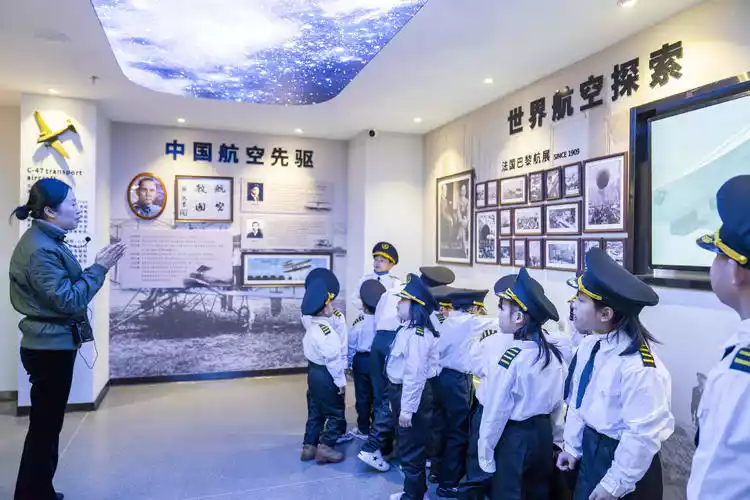
Following the course of history and visiting step by step, this kind of study tour is really great.

The first airplane invented by mankind was invented by the Wright brothers, which is only more than a hundred years ago. The development of aviation is still very rapid.

The display windows in the exhibition hall are very attractive. Inside are various aircraft models, including all current civil airliners, as well as various fighter jets and helicopters. It is dazzling and delightful.

Part 3: Interactive Experience Room in the Science Popularization Center
Through various simulation interactions, the principle of the aircraft's stable flight is demonstrated. The engine, propeller, wing lift, gyroscope, etc. correspond to different working principles.
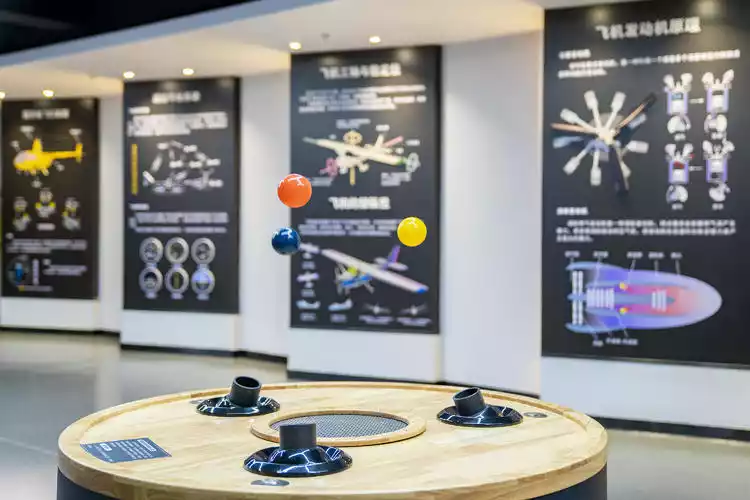
Part 4: Simulated aircraft in the Science Center
You can experience the joy of flying an airplane by sitting in the cockpit. The 3D simulation screen matches the interaction with the operation panel. It is a very realistic interactive game that allows you to experience the excitement of flying an airplane.

Hands-on session
The Xinlian Aviation Science and Technology Center has two floors in total. The first floor is where we just visited all the parts, and the second floor is where there are computer classrooms, handicraft classrooms and office areas.

Members of the model aircraft team gave lessons to the children, asking them to make a small aircraft by themselves. After visiting the history of aviation development, they were given something practical to help the children deepen their impressions.
First, we explain the components of the aircraft, then we break it down and guide the children step by step to complete the construction of the aircraft. This kind of activity should be the favorite of children. Assembling a flying "toy" by themselves is a lot of fun.

Model aircraft flying makes the dream of blue sky come true
In the morning, there is indoor teaching, and in the afternoon, there are outdoor activities. The outdoor activity area has five special activity areas, including Xinlian Aviation outdoor teaching, remote control flying, and lawn flying, which are used to carry out large-scale aviation model performances, remote control flight experience, hot air balloons, karting and other experience projects.

What is going on today is an aviation model show. Various homemade model aircraft are placed in the waiting area. They are of different shapes and types, but they are all realistic aircraft models and equipped with remote controls. You can also think of them as "toys", high-end professional flying toys.

The model aircraft performance is performed by members of the model aircraft team. Children and tourists can only watch from the audience area. Although the model aircraft is not a real airplane, it can soar in the blue sky like an airplane, so it needs a certain amount of space for exercise. Remember not to get too close.
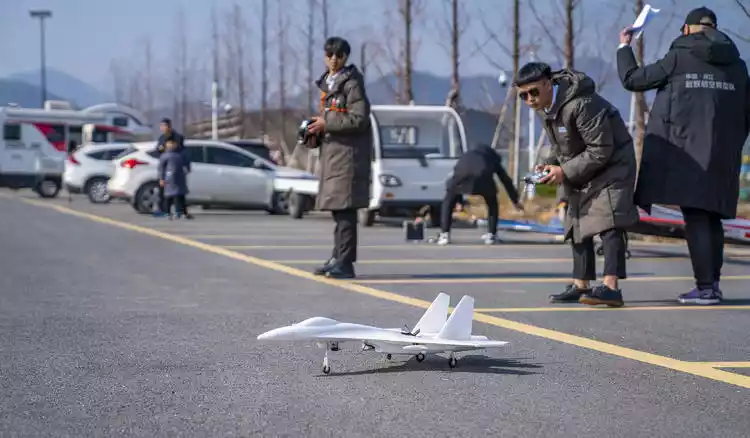

Model aircraft are the fundamental step in studying aircraft. By using model aircraft flight and experiments to collect more data, we can contribute to scientific research. Innovative interest and thinking are also an important part of the development of the aviation industry.

Model aircraft is a professional aviation sport involving the flying and control of homemade aircraft models for competition and record-breaking flight. There are four main categories, categorized as free flight (F1), line-controlled circular flight (F2), radio-controlled flight (F3), and lifelike models (F4), totaling 26 types. Professional model aircraft championships are held nationwide and internationally.

Helicopter view of Qiandao Lake
When you come to the Aviation Town, you still have to try some real things. There are many high-altitude experience projects here to participate in, including helicopter aerial tours, hot air balloons, skydiving, helicopter diving, etc.

We chose a helicopter aerial tour, which is a short-distance route opened by Xinlian General Aviation. It includes a total of nine different routes, with fees ranging from 680 yuan/person to 5,880 yuan/person. The tour time ranges from 10 minutes to 70 minutes. A helicopter can accommodate three people. The tour area covers Qiandao Lake and surrounding attractions in Jiande and Lanxi, including Tianchi Island, Mishan Island, Moonlight Island, Xin'anjiang Dam, Meicheng Ancient Town, Shangjiangbu Bridge, Shouchang River, Guang'an Zen Temple, Daciyan, etc.

The place to experience flying is at the Xinlian Aviation Club, which is just opposite the Xinlian Aviation Science and Technology Center. Although the helicopter does not fly high, you can't fly whenever you want. The base is based on the Jiande Qiandao Lake General Airport, where flight training, aircraft pilot license training and other projects can also be carried out.

The process of taking a helicopter tour is the same as that of taking a plane. You also need to complete a series of procedures such as check-in, waiting, and boarding. The waiting room is very casual, and professional pilots are in a meeting.

Various inspections and preparations need to be completed before takeoff. I was very excited to see the helicopter at such a close distance.

There is another helicopter in the maintenance garage, which is also very cool.

Happy Village
Xingfu Village is a village under Qiantan Town. The country is vigorously developing rural tourism, and Xingfu Village is one of them. With drizzle and mist lingering in the mountains, the whole village looks like a fairyland at the foot of the mountain.

The Happiness Workshop, located at the entrance of the village, is a great place to visit in the village.
When you walk inside, you will find that this is actually a farm museum, where many ancient objects are collected. These are the memories of our parents, including many that I know but have never used. What's more, children today may not even know what these are.

The traditional hand-cranked popcorn machine is also equipped with two wooden blowers, which is very scene-like.

VCD, DVD, after a round of rotation, these are the only things I have ever used. They are left in my primary school memories. I can only blame the fact that the times are changing too fast. The tapes and Subor from our time no longer exist.

When I see a typewriter, the mechanical sound of clicking and clacking comes to my mind.
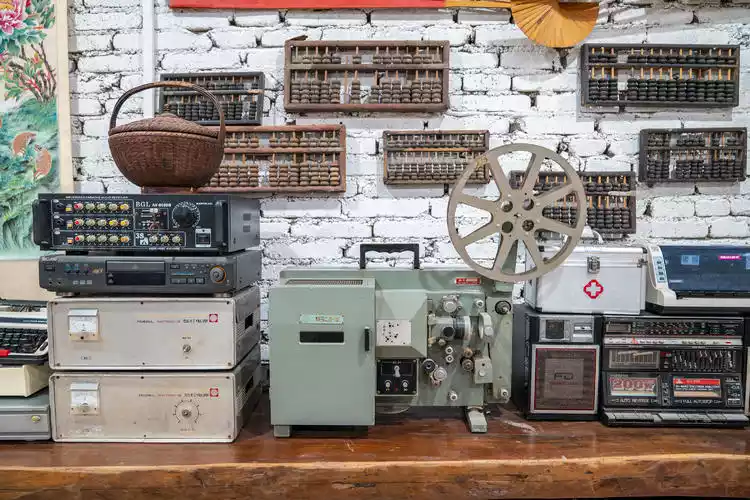
Are you as surprised as I am to see these rich collections? However, these are not public, but personal. They are collected by the boss from all over the place. They are very rare. It will be very difficult to see these things in the future.

I particularly enjoy these things about movies. You know, in the past, there was a profession called movie projectionist, who would lug heavy film equipment to various towns, villages, schools, government agencies, and other places to show movies. They were like mobile movie theaters. I remember watching these open-air movies as a child, carrying my own stools and snacks, and squeezing in with the crowds. The one that left the deepest impression on me was "The Wanderings of Sanmao."

It is said that the images on the movie film can actually be played. If you pull it out and look at it carefully, you can clearly see the patterns on it.

The tin box on the left is used to store film, and the cloth bag on the right is the movie screen. Times have changed, society has developed rapidly, and those memories of the past are so beautiful when recalled.





